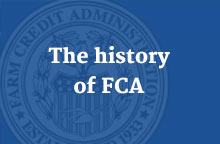 President Franklin D. Roosevelt, who signed the executive order creating FCA, visits with a North Dakota farmer in 1936. (Library of Congress Prints and Photographs Division)
President Franklin D. Roosevelt, who signed the executive order creating FCA, visits with a North Dakota farmer in 1936. (Library of Congress Prints and Photographs Division)
History of FCA
The history of agricultural credit, FCA, and the FCS parallels the extraordinary challenges of the frequent boom-and-bust cycles that have occurred since the first World War.
Farmers have been among the most vulnerable workers to these cycles. The nature of farming does not allow for quick turnarounds, particularly after farmers have made major investments in land, equipment, and crops.
Before Congress authorized a system of longer-term loans for farmers to reflect this reality, the lack of suitable credit forced many thousands of farmers to abandon their livelihood and its way of life. Losing so many family farms was not only a tragedy for farming families, but also for rural America. This is as true today as it was 90 years ago.
The history of FCA and the FCS explains how Congress sought to assist farmers by meeting their changing credit needs. Congress recognized that meeting these needs was essential to promote a thriving agricultural industry and vibrant rural communities.
This site also describes the events of the 1980s that threatened the existence of the FCS and the availability of affordable agricultural credit. In addition, you will meet the governors who developed the agency through its formative years and the board members who steered it in more modern times.
Through it all, we hope you will come away with a sense of the commitment of this country to agriculture and to farming families.
See our historical highlights.
History of FCA and the FCS
-
The concept of a reliable source of credit for the nation’s farmers dates back to 1732, when the first cooperative credit system was organized in New London, Connecticut. Government intervention to meet this need, however, particularly for long-term credit to purchase land, only started in the early 19th century. It was then that most of the free land available in the West under the Homestead Act of 1862 was claimed, and farmers needed long-term credit to purchase land. However, whereas credit from commercial banks was readily available for business and industry, it was scarce and short term, and at high interest rates for agriculture. With land values rising, the need for long-term fixed-rate credit became acute.
-
Starting in 1908 in the administration of President Theodore Roosevelt, the Country Life Commission and congressional committees studied the problems facing rural families, who constituted the majority of households in America at that time. In its report (PDF), the commission recommended a nationalized extension service, which was formalized by the passage of the Smith-Lever Act in 1914. It also recommended a campaign for rural progress and additional fact-finding surveys, which fostered the development of agricultural economics and rural sociology in universities and the federal government.
In 1912 and 1913, Presidents William Howard Taft and Woodrow Wilson sent commissions of ambassadors to Europe to study cooperative land-mortgage banks, rural credit unions, and other institutions that promoted agriculture and rural development. The Wilson commission recommended a system of agricultural banks to provide both long-term, or land-mortgage credit, and short-term credit to meet recurring needs. Congress responded with the Federal Farm Loan Act of 1916.
-
The Act established a federal land bank (FLB) in each of 12 districts across the country, along with hundreds of national farm loan associations (NFLAs) to serve as agents for the FLBs. The FLBs were the first component of what eventually came to be known as the Farm Credit System (FCS). The FLBs, through their agent associations, provided long-term credit to farmers to develop and expand farms. Part of each farmer’s loan bought stock in the association, making the individual farmers owners of the association. This concept of land banks came from Germany’s successful, century-old Landschaft system.
What the 1916 Act lacked, however, was a provision for short-term loans. Increased mechanization in agricultural production in the post-World War I years, which created cost pressures, and competition from Europe in the 1920s spurred a need for short-term credit. Congress responded with the Agricultural Credits Act of 1923, which created 12 federal intermediate credit banks (FICBs), one in each of the 12 districts established under the 1916 Act.
The FICBs did not lend directly to individuals but served as banks of discount to agricultural cooperatives, commercial banks, and other lending institutions. Expectations that commercial banks would participate in great numbers were not realized, however, and so the FICBs did not significantly improve the flow of short-term credit to farmers.
Soon after, the nation was mired in the Great Depression. Prices for farm commodities had been falling all through the 1920s as the wartime need for those commodities ended, but now substantially accelerated. Farmers, unable to pay their expenses and loan payments, walked away from their farms, leaving the FLBs with numerous defaults. By 1933, nearly one-half of the NFLAs were failing, and farm foreclosures were common. Congress stepped in with two new laws.
-
The Emergency Farm Mortgage Act attempted to save the farms of individuals delinquent on their loans by extending repayment schedules and offering emergency financing.
-
The Farm Credit Act completed the establishment of the Farm Credit System by creating two new types of institutions, which expanded the lending authorities of the FCS so it could now provide credit for all types of agricultural activities. As a result, the FCS consisted of the following:
- Twelve FLBs for long-term agricultural real estate loans through FLB associations
- Twelve FICBs for short- and intermediate-term credit to local production credit associations (PCAs) and other lending institutions serving agricultural producers
- Twelve banks for cooperatives (BCs) to provide credit for farmers’ cooperatives
- A central bank for cooperatives to participate with the district BCs in loans that exceeded their lending capacities
An executive order by President Franklin D. Roosevelt in 1933 placed all existing agricultural credit organizations under the supervision of a new agency, the Farm Credit Administration (FCA). FCA was independent until 1939, when it became part of the U.S. Department of Agriculture (USDA), but became an independent agency again under the Farm Credit Act of 1953. This Act created a federal Farm Credit Board with 13 members (one from each of the 12 farm credit districts and one appointed by the Secretary of Agriculture) to develop policy for FCA. Farmer-borrowers now had a voice at the national level.
FCA also played a pivotal role in the federal credit union movement, when in 1934 it was given responsibility for chartering, examining, and supervising all federal credit unions. Before this oversight was turned over to the Federal Deposit Insurance Corporation in 1942, FCA had chartered more than 4,000 credit unions and examined them annually.
-
FCA becomes an independent agency again under the Farm Credit Act of 1953. The Act creates a Federal Farm Credit Board with 13 part-time members—one from each of the 12 agricultural districts and one appointed by the secretary of agriculture—to develop policy for FCA. From then on, it is this board—not the president—that appoints future governors. Robert B. Tootell is the first governor appointed by the board (in 1954).
More than half of the production credit associations have paid back their government capital, a credit to the vigorous efforts of Governor (and previous production credit commissioner) Carl Arnold.
-
All government capital to the FCS was repaid by 1968, making FCS institutions wholly owned by their farmer-borrowers. FCA determined that its authorities and those of the FCS needed to be expanded to meet the changing credit needs of farmers and rural communities. The Farm Credit Act of 1971, the outcome of recommendations of a commission established by the federal Farm Credit Board, gave the banks and associations more flexibility in lending to production agriculture, and authorized lending to commercial fishermen and rural homeowners. In 1980, the law was amended to encourage lending to young, beginning, and small farmers.
The institutions of the FCS grew rapidly in the 1970s and early 1980s, when loan volume topped $80 billion. The boom years of the 1970s saw farmers borrow heavily to expand their operations to meet the great demand for U.S. agricultural exports, particularly to the Soviet Union, where drought conditions had caused severe grain shortages. Double-digit inflation raised prices on farm products and boosted the value of farmland.
The end of the boom commenced in 1979 with the tightening of currency by the Federal Reserve Board to rein in inflation. In the early and mid-1980s, interest rates soared and foreign demand for domestic agricultural products fell as the European Community and developing countries also expanded their agricultural sectors. The high inflation led to unfavorable monetary exchange rates, making U.S. products more expensive in foreign currencies. A debt crisis in several less-developed countries further constrained imports of U.S. products.
The dramatic shift in macroeconomic policies occurred after U.S. farmers geared up to meet the demand of the 1970s. Now the dried-up demand created huge surpluses, lower prices, and lower incomes to repay loans. By 1985, an estimated 200,000 to 300,000 farmers were facing financial failure, and farmland values had dropped drastically. For 1985 and 1986, FCS institutions reported net losses of $2.7 billion and $1.9 billion, respectively, the largest losses in history for any U.S. financial institution. When it became apparent that the financial viability of the FCS was at risk, Congress again stepped in to provide relief.
-
The 1985 Act restructured FCA to give it increased oversight, regulatory, and enforcement powers similar to those of other federal financial regulatory institutions. It also provided for a full-time, presidentially appointed three-member board, with one member serving as chairman and chief executive officer of FCA. FCA was required to examine each direct-lending institution at least annually and could use its new enforcement authority to instill safe and sound banking practices on troubled institutions and to correct any regulatory violations. The enforcement powers include formal agreements, cease-and-desist orders, civil money penalties, and suspension of officers and directors.
The 1985 Act also set up the Farm Credit System Capital Corporation to give technical and financial assistance to financially weak FCS institutions and their borrowers. However, it soon became apparent that the Capital Corporation was not equipped to deal with the monumental problems facing many of the FCS’s borrowers and that some form of direct federal assistance was needed.
-
The Agricultural Credit Act of 1987 authorized up to $4 billion in federal assistance to troubled institutions, including up to $2.8 billion in Treasury-guaranteed 15-year bonds. A new FCS Financial Assistance Corporation was formed to issue the bonds, and an FCS assistance board was set up to manage the program. The Act also created the Farm Credit System Insurance Corporation (FCSIC) to ensure timely payment of interest and principal on Systemwide and consolidated bonds and other obligations issued by FCS banks. In addition to easing borrower flight by guaranteeing existing stock at par value, the Act also strengthened borrower rights in a number of important ways.
The Act also mandated structural changes to FCS institutions, including a merger of the FLBs and FICBs in each district into a district farm credit bank (FCB). PCAs and FLBAs in the same territory were allowed to merge voluntarily into a new entity, the agricultural credit association (ACA), and the BCs were also given the opportunity to merge. Federal land credit associations (FLCAs) were established as direct lenders that could make long-term mortgage loans. All these structural changes made the FCS more efficient.
The Act also created the Federal Agricultural Mortgage Corporation (Farmer Mac) to establish a secondary market for agricultural real estate and rural home mortgages. The Farm Credit System Reform Act of 1996 gave Farmer Mac further authority to purchase and pool loans and issue mortgage-backed securities with guaranteed payment of principal and interest, rather than just guarantee such securities issued by other retail lenders.
-
The financial assistance by the government and FCA’s new policies and enforcement authority helped the FCS recover from the crisis years of the 1980s, regain safe and sound practices, and become more efficient. A stronger economy in the 1990s and 2000s further stabilized the FCS as farm prices and incomes rose. For the past several years, the FCS’s share of the agricultural debt market has been increasing and now accounts for about 40.7 percent of farm business debt.
All government financial assistance was repaid, with interest, by 2005. FCA itself does not receive any government appropriations; rather, FCA operations are funded through assessments paid by FCS institutions.
Today, the FCS is structured into
- three FCBs;
- 72 ACAs and one FLCA, each of which receives loan funds from the farm credit bank with which it is affiliated; and
- one agricultural credit bank (CoBank), which has the authority of an FCB (in that it provides loan funds to 23 ACAs and one FLCA) and the authority of a BC (in that it lends to agricultural and aquatic cooperatives and rural utilities; finances U.S. agricultural exports and imports; and provides international banking services for farmer-owned cooperatives).
Today, most of the associations have adopted the ACA parent structure with wholly owned PCA and FLCA subsidiaries to disburse short-, intermediate-, and long-term loans. This structure enables an integrated, full-service lending business. The three associations agree to guarantee each other’s debts and obligations, pledge their assets as security for their direct loans from the FCB, and combine their capital and assets to absorb any losses. They share the same board of directors, management, and staff. The objective is to meet the credit and financial service needs of customers in the most cost-effective manner possible.
Realizing that vibrant rural communities are key to supporting agriculture and farm families and especially in encouraging young people to farm, FCA remains committed to ensuring a reliable source of credit to finance agriculture and rural America.



